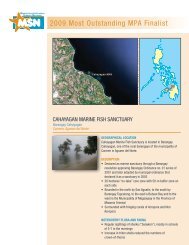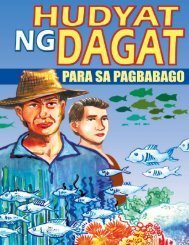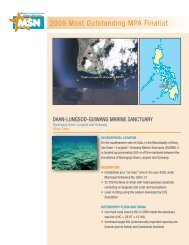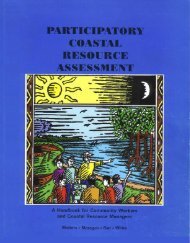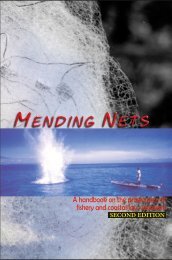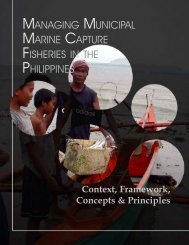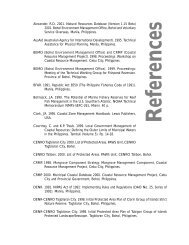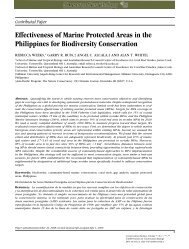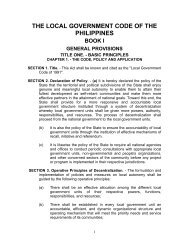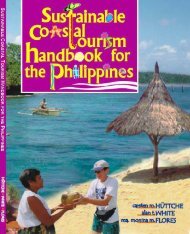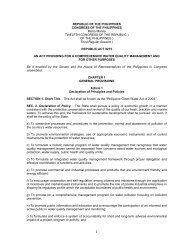Part 2 - Oneocean.org
Part 2 - Oneocean.org
Part 2 - Oneocean.org
- No tags were found...
Create successful ePaper yourself
Turn your PDF publications into a flip-book with our unique Google optimized e-Paper software.
Km of shoreline35003000250020001500100050001996ActualTarget0 0 132Fig. 7.3. Kilometers of shoreline “completed”management of coastal resources by municipalities.CRMP and the Fisheries Resource Management Project(FRMP) signed a Memorandum of Understanding(MOU) in 1999, linking the two largest coastal projectsin the Philippines. FRMP, a project of the BFAR fundedby the Asian Development Bank (ADB), is adoptingCRMP-developed products including: (1) trainingmodules on ICM, PCRA, and Mangrove Management;(2) IEC materials such as posters and pamphlets; and(3) the MCD for use in 18 bays covering 100municipalities in the Philippines.A similar collaborative arrangement was made withthe USAID-funded GOLD project. CRMP and GOLDhave developed joint CRM activities for GOLD roll-outsites in Negros Oriental and Bohol. GOLD is also makinguse of the CRMP-developed training modules, IECmaterials, and the MCD. The use of theMCD enables two collaborating USAID 300projects to contribute to and report250accomplishments under a common set ofindicators.200SO4 2 Percentage change of fish abundanceand coral cover inside and adjacent to marinesanctuaries: Biophysical impacts ofimproved local implementation of CRM aremeasured using standardized monitoringmethods developed in partnership with theUP-MSI. Annual assessments of fishabundance (focusing on key fish families that407416701200Percent change compared to baseline210015010050030001997 1998 1999 2000 2001 2002Yearare commonly targeted for harvest) and live coralcover are conducted in 6 marine sanctuaries, onein each Learning Area.The results of surveys conducted in 1999show fish abundance increased some 255% abovethe baseline inside marine sanctuaries (versus a1999 target of 10%) and 70% above the baselineadjacent to marine sanctuaries (versus a target of0%). These high percentage changes may be attributedto the extremely low baseline figures for fish populationsdue to the degraded and poorly managed condition ofthe these sanctuaries during the baseline year. (Fig. 7.4)Live hard coral cover increased 40 percent above thebaseline inside marine sanctuaries (versus a 1999 targetof 5 percent) and decreased -7 percent below the baselineadjacent to marine sanctuaries (versus a target of 0 percent;Fig. 7.5). Record high tropical sea surface temperaturesduring the 1997-1998 El Niño event resulted in coralbleaching throughout coral reefs in the Philippines as wellas the Indo-Pacific Region. In 1999, unusually heavy rainspersisted in many areas of the Philippines and localizedoutbreaks of the coral eating, crown-of-thorns seastar,Acanthaster, were noted. Changes in living coral cover insanctuaries monitored by CRMP were influenced by theselarge-scale climatic events. Overall, the strength ofmanagement activities in marine sanctuaries monitoredin CRMP Learning Areas is increasing with active92212255 Inside ActualAdjacent ActualInside TargetAdjacent Target701998 1999 2000 2001 2002YearFig. 7.4. Percent change of fish abundance inside and adjacent tomarine sanctuaries56



